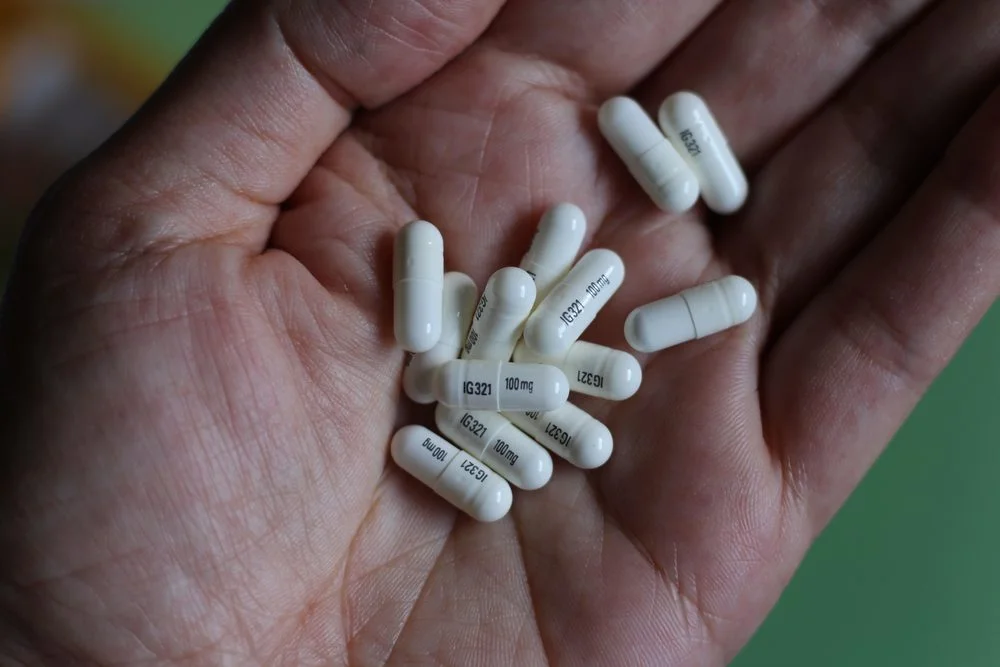Gabapentin
Gabapentin is an anticonvulsant that is used to treat a variety of conditions such as neuropathic pain, epileptic seizures, and postherpetic neuralgia, among others.

Common Trade Names: Neurontin, Gralise, Gabarone, FusePaq Fanatrex
According to available scientific literature, gabapentin is believed to alter electrical activity in the human brain and curb the production of glutamate, a substance that excites the brain’s nerves and contributes to epileptic seizures. These effects account for gabapentin’s effectiveness in treating epileptic seizures.
Gabapentin can also increase the amount of gamma-Aminobutyric acid (GABA) produced in the brain, thus affecting the excitement of the brain’s nerve impulses. This effect is responsible for the feelings of calm or relaxation experienced by individuals who use this drug.
It should be noted that gabapentin is not an opioid. Also, when taken on its own, gabapentin’s addictive potential is not nearly as high as that of opioids. However, gabapentin is considered an opioid potentiate because it can accelerate the high that’s felt with substances like hydrocodone, oxycodone, morphine, codeine, and fentanyl. Additionally, a study published in the journal Addiction found that 15 to 22 percent of individuals who abuse opioids also misused gabapentin.
That being said, it is not out of the realm of possibility that someone may end up abusing gabapentin on its own. Users may develop behavioral dependence or psychological dependence on the drug, and they may experience withdrawal symptoms if they suddenly stop consuming it.
Medical Applications of Gabapentin
Gabapentin has been approved by the US Food and Drug Administration (FDA) for treating the following conditions:
- Postherpetic neuralgia: a lasting pain on areas of the skin affected by a viral infection known as shingles
- Moderate to severe restless leg syndrome: a nervous system disorder that causes an uncontrollable urge to move one’s legs
- Adjunct therapy in partial seizure treatment: using gabapentin together with other ways of treating partial seizures with or without secondary generalization in:
- Patients with epilepsy, aged 12 or older
- Pediatric patients with partial seizures, aged 3 to 12
Gabapentin is also used off-label for the following conditions:
- Alcohol withdrawal: symptoms resulting from a sudden decrease or cessation of alcohol intake
- Anxiety: a feeling of intense worry, fear, or uneasiness
- Bipolar disorder: a mental disorder characterized by extreme mood swings and unusual shifts in energy levels
- Essential tremors: a neurological condition characterized by involuntary shaking or rhythmic body movements
- Fibromyalgia: a condition characterized by chronic fatigue and widespread musculoskeletal pain
- Generalized tonic-clonic seizures: seizures characterized by stiffening, jerking, and twitching of the muscles
- Headaches: throbbing or constant pain that can affect any part of the head
- Insomnia: difficulty sleeping
- Interstitial cystitis: chronic feelings of pressure and pain in the bladder area
- Irritable bowel syndrome: a gastrointestinal condition characterized by diarrhea, stomach cramps, bloating, and/or abdominal pain
- Nausea and vomiting: stomach uneasiness or discomfort that may result in a forceful discharge of the stomach’s contents
- Neuropathic pain: chronic burning or shooting pain due to damage to the central nervous system
- Painful diabetic neuropathy: nerve damage that can occur in individuals with diabetes
- Post-traumatic stress disorder: a mental health disorder that can develop after experiencing severe psychological shock
- Postmenopausal hot flashes: a sudden feeling of heat, most typically in the face, neck, and chest
- Pruritus: itching of the skin
- Refractory chronic cough: a cough that lasts longer than eight weeks even after following guideline-based treatment
- Resistant depressant and mood disorders: conditions that do not improve even after treatment
- Social phobia: intense feelings of anxiety, fear, and self-consciousness in social settings
Additionally, gabapentin can also be used for:
- Migraine prophylaxis: treatments for preventing migraines
- Postoperative analgesia: pain relief medications that are administered after an operation
Gabapentin Abuse and Misuse
The general public might assume that it’s hard to abuse gabapentin if one has to go through the additional difficulty of getting a prescription. But in truth, people have found ways to circumvent the system and sell legally prescribed gabapentin to unprescribed users under the table. In fact, numerous admissions to treatment centers for gabapentin abuse involved patients who took the medication without a prescription.
Among those who are directly prescribed gabapentin by their physicians, there’s a danger to abuse or misuse the medication in the following ways:
- Self-medication: using a drug without consulting a medical professional, or not using the drug as prescribed
- Improper routes of administration: taking the substance in unintended or unapproved ways, such as by crushing and snorting gabapentin tablets or crushing, dissolving, and injecting gabapentin into the body
- Opioid potentiation: using gabapentin to enhance the high provided by opioids
- Overdosing: taking gabapentin in higher doses than recommended
- Prescription abuse: obtaining gabapentin by lying about symptoms, forging prescriptions, or sourcing gabapentin from multiple doctors
- Poly-substance abuse: using gabapentin in combination with other drugs (most commonly opioids)
- Recreational use: using gabapentin for its desired effects rather than for medical purposes
Known Gabapentin Drug Interactions
Current research suggests that there are no significant interactions when gabapentin is taken in combination with other antiepileptic drugs. Examples of such medications include carbamazepine, lithium, and valproate.
However, gabapentin may cause undesirable effects when administered with any of the following substances:
- Hydrocodone: Taking gabapentin with this drug can reduce hydrocodone exposure.
- Morphine: The use of gabapentin in combination with this medication may cause central nervous system (CNS) depression. Symptoms of this condition include:
- Respiratory depression
- Sedation
- Somnolence
- Antacids containing magnesium and aluminum hydroxides: When this drug is coadministered with gabapentin, the ability of gabapentin to be absorbed by the body has been found to decrease by approximately 20 percent.
Known Short-term Adverse Effects of Gabapentin Abuse
Notable side effects that may manifest upon one’s use or abuse of gabapentin include the following:
- A lack of or difficulty with coordination
- Double vision
- Fatigue
- Fever
- Jerky movements
- Nausea
- Sleepiness or drowsiness
- Swelling in the feet or legs
- Tremors
- Unusual eye movements
- Viral infections
- Vomiting
Some side effects may point to a serious adverse drug event after taking gabapentin. These may include:
- Bluish color in the lips, fingernails, or skin
- Confusion
- Difficulty breathing or swallowing
- Extreme sleepiness
- Hoarseness
- Itching or rashes
- Seizures
- Swelling of the eyes, face, lips, tongue, or throat
If you or another person are exhibiting any of these serious side effects, contact a medical professional or 911 immediately.
Known Long-term Adverse Effects of Gabapentin Use
Long-term use of gabapentin for its approved and off-label medical applications has not been found to cause serious or lasting side effects. However, at least one clinical study has noted less serious side effects in individuals who took the medication for a three-year period. The most common long-term adverse effects were:
- Dizziness
- Forgetfulness
- Sedation
Signs of Gabapentin Overdose
By itself, gabapentin is considered to have little to no risk of an overdose.But while taking too much of this medication is typically not dangerous, it can become lethal when ingested with other psychoactive drugs such as sedatives and opioids.
Additionally, it is still possible to overdose on the medication if you take it in extremely high dosages. Symptoms that may indicate that an individual has overdosed on gabapentin include:
- Diarrhea
- Double vision
- Drowsiness
- Slurred speech
Indeed, while gabapentin overdoses are rare, there do exist reports of such incidents. One such case involved a 59-year-old patient who experienced mild sedation and nausea after ingesting too much of the drug. However, the patient did not develop any other conditions as a result of the overdose.
The study, published in the journal Military Medicine, concluded that while individuals may experience undesirable side effects after taking too much gabapentin, the drug has “a wide therapeutic margin and may be safe in overdose” if ingested on its own. There are also many other reports of individuals surviving gabapentin overdoses.
That being said, there have also been cases with results to the contrary, wherein gabapentin overdoses resulted in death. One case involved a 67-year-old white male who passed away due to acute gabapentin intoxication. Another case involved a 62-year-old woman who died after intentionally taking extremely high doses of gabapentin. Her case is also considered the first published report of a death caused by a gabapentin overdose.
Common Gabapentin Withdrawal Symptoms
For patients who have been taking gabapentin regularly for their intended purposes, abruptly stopping is not recommended. This is because the abrupt cessation of gabapentin intake may result in withdrawal syndrome. Common symptoms include the following:
- Ataxia (losing control of one’s body movements)
- Dizziness
- Fatigue
- Nausea
- Somnolence (feeling drowsy or sleepy)
- Vomiting
Individuals who have been taking higher than recommended doses of gabapentin for recreational or non-medically approved uses also should not suddenly discontinue using the drug. Otherwise, these individuals may experience some or all of the following withdrawal symptoms:
- Agitation
- Confusion
- Disorientation
Gabapentin and Its Potential for Abuse
While there are many reports of gabapentin abuse and misuse across the US, current scientific research shows that gabapentin, by itself, does not have addictive properties. At present, studies have not found sufficient evidence of individuals looking to get treated for gabapentin use disorder, either.
That being said, gabapentin is still being studied by addiction treatment professionals for its effects when misused in particular contexts, such as alongside opioids. At least one US study has found that recreational use of gabapentin can cause an individual to develop tolerance, physical dependence, and withdrawal. These are all effects that have also been found to result from the recreational use of controlled substances.
It is also interesting to note that pregabalin, a substance that is structurally close to gabapentin, is currently classified as a Schedule V drug. This means that federal authorities have acknowledged pregabalin’s abuse potential, but not that of gabapentin. Nonetheless, gabapentin has already been listed as a Schedule V drug in some states, including Kentucky, Michigan, Alabama, Tennessee, and West Virginia.
Based on these observations, many medical professionals recommend a re-evaluation of gabapentin’s abuse potential and a re-examination of its lack of scheduling. Though the US federal government has not yet classified gabapentin as a narcotic, some states have listed it under their prescription drug monitoring program. Authorities note the potential of prescription abuse around the drug, especially since the amount of gabapentin a patient can have at one time isn’t restricted. Additionally, recent studies have found that patients with a history of opioid use disorder are also more likely to abuse gabapentin.The Difference Between Gabapentin Dependence, Withdrawal, and Addiction
At present, gabapentin is not considered to be an addictive substance. However, it is still possible to abuse the medication and experience withdrawal symptoms after abrupt cessation of gabapentin administration.
It is also important to note that drug dependence and drug addiction are not the same thing. As such, experiencing withdrawal symptoms does not necessarily mean that you have become addicted to the medication. Rather, these symptoms may be a sign that you have become dependent on the drug.
To put it simply, drug dependence happens when your body has become accustomed to the presence of a particular substance. Because of this, the sudden absence of the substance in question may cause you to experience physical and mental withdrawal symptoms. Substance abuse patients are typically asked to undergo detoxification as the first step in the continuum of care. Detox is a set of interventions aimed at managing acute intoxication and withdrawal syndrome that may manifest due to dependence on the drug.
By comparison, drug addiction or substance use disorder is a condition that is characterized by an individual’s inability to stop taking a substance despite its harmful effects on the person’s physical and mental wellbeing. Substance use disorders are typically addressed through addiction treatment and rehabilitation.
Getting Help for Gabapentin Abuse
Gabapentin abuse is a serious problem that may have many underlying layers. For individuals struggling with the condition, it can be hard to stop using gabapentin.
In most cases, drug rehab centers are still the best recourse for anyone showing signs of drug abuse or substance use disorder. Here, you or your loved one can enroll in a personalized program for gabapentin abuse and receive proper medical treatment. These treatments are usually carried out in one of two types of settings, which are:
- Inpatient treatment: Considered to be the more intensive of the two options, inpatient treatment means that you will have to reside at the treatment center until you’re done with the program. A team of medical professionals will provide you with a mix of treatment modalities. They may, for example, give you certain medications for treating adverse symptoms of the drug or any comorbidities you may have. Depending on the severity of your case, you may also be asked to partake in cognitive behavioral therapy and undergo individual or group counseling. Therapy and counseling will prove vital in developing awareness of your unhealthy behaviors around gabapentin. These two interventions will also help you learn healthier coping techniques and strategies for avoiding relapse.
- Outpatient treatment: This setup is typically recommended for people who exhibit much milder symptoms related to drug abuse or dependence. With this setup, you will be allowed to keep living at home for the duration of the program. However, you will be required to attend regular therapy and counseling sessions at your assigned treatment center. Between the two rehab settings, outpatient rehab gives you more freedom when it comes to your schedule. As long as you don’t miss your therapy and counseling sessions, you can continue reporting to work, attending classes at school, and partaking in your other daily activities.
If you see the signs of gabapentin abuse in yourself or a loved one, now is the right time to respond and get specialized treatment at a rehab center.
As for how to pay for said treatments, don’t worry. Your insurance plan likely provides coverage for drug addiction treatment services. If it doesn’t, you’re not necessarily out of options. Fortunately, there are lots of other ways to finance inpatient or outpatient addiction treatment programs.
Dial (800) 429-7690 today and you’ll be connected to one of our experienced recovery support advisors. With their assistance, you can quickly and easily verify your insurance. That way, you’ll know exactly how much of your treatment your insurance plan can cover. The recovery support advisor can also help you when it comes to finding a treatment center that suits your budget and preferences.
A Brief History of Gabapentin
Gabapentin was first marketed as a muscle relaxant in Japan, back in the 1970s, before its anticonvulsant properties were discovered. The drug was approved for medical use in 1993. It was later made available as a generic drug in the United States in 2004.
Though fairly new to the market, gabapentin already has its fair share of controversy thanks to the company Parke-Davis, a subsidiary of pharmaceutical giant Pfizer. In the 1990s, Parke-Davis encouraged American doctors to prescribe the drug for off-label uses. The company has already settled millions of dollars in lawsuits due to this illegal practice.
As of 2016, gabapentin was the tenth most commonly prescribed medication in the country, accounting for 64 million prescriptions. As many as 13.1 million Americans filled in gabapentin prescriptions that year, a notable increase of almost 5 million from four years before.







